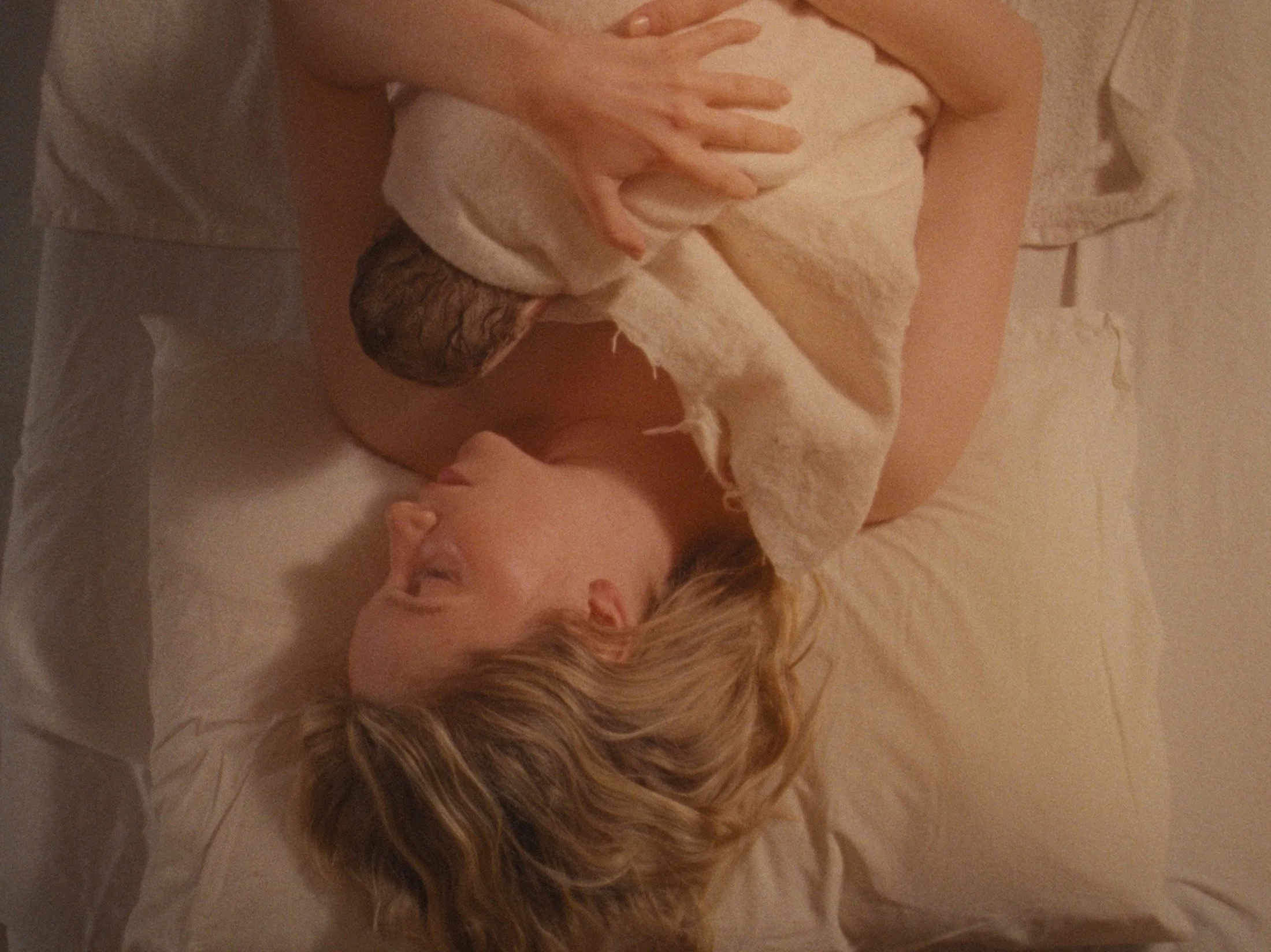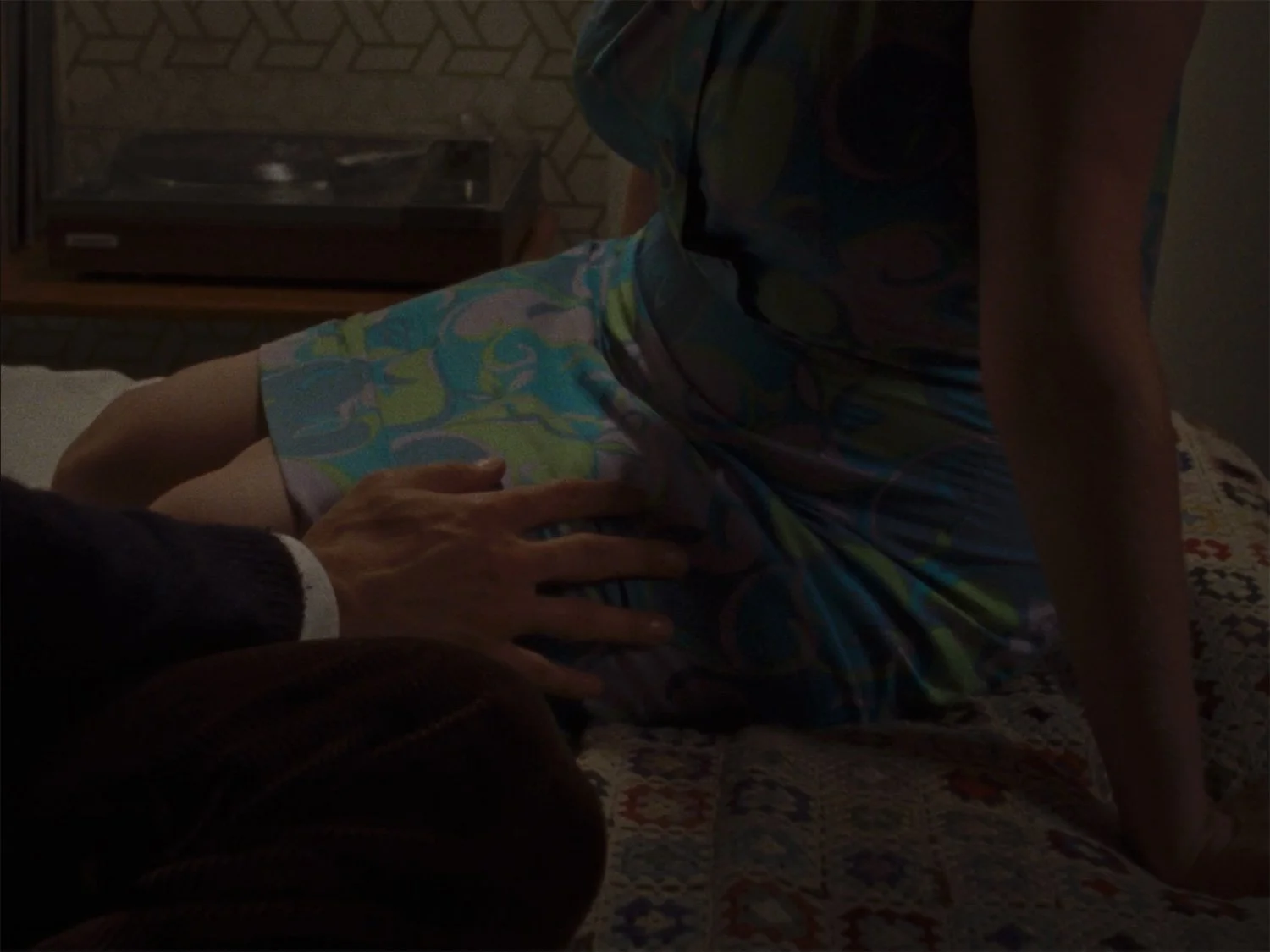Solidago
Solidago is a film by Jerusha West about a female community in Britain, an ultimate short-term escape from the societal norms in the 1960s during the Baby Scoop Era. The film tells the story of Edith, sent to the community to give birth to her child, conceived outside of marriage. Saturated with symbolic elements which assist in depicting psychological trauma that surfaces with the culmination in the final scene, the separation of the mother with her child, the tension is built with the main scenes and the elements of sound and editing. The team explains this profound interest in the Baby Scoop Era, “Jerusha’s mother was adopted in 1969, and her biological grandmother (aged 16 at the time) was sent away to give birth secretly and so the desire to look more closely and open dialogue around this period of women's history also tied into the origins of Solidago.”
We speak with the Solidago team about the need to shed light on the forgotten period in women’s history of the past century, the desire to emphasize the trauma brought on women and the suppression of their experiences. The team describes in detail the key scene, the plucking feathers of the bird, and the origin of the shots with the underlying message. We dive deep into the discussion of editing, music and sound post-production, and color and the importance behind each component. Solidago was shot on 16mm ARRI and Bolex cameras.
Director & Writer Jerusha West
Starring
Rosemary Boyle Rose Keegan Priya Blackburn Ziggy Heath Bill Hurst Poppy Keating Eve Stotesbury Phoebe Averdieck Shayna Fonseka Leila Al-Yousuf Samantha | Ndubuisi Kanu Alice Kasahara Bryony Farmer Janice Holland Lara Boyle Remy Roberts Rosamond Sutton Grace Stotesbury Isabelle Martin
Co-creator and co-writer Geoffrey Hazelton-Swales Producers Sara Pagliaro Megan Townley-Wakelin Associate Producers Tate Turnbull Britt Soderberg DOP Morgan K. Spencer Editor Catriona Delbridge Music Sampo Costume Design Sophie Daniel Production Design Syd Harmony HMU Zoë Dennis Sound Recordist CraigCassie 1st AD Carlotta Beck Peccoz 1st AC Lawrence Beckwith Felix Pickles 2nd AC’s Saskia Dedman & Anastasia Romanchuka Steadicam Hannah Jell Camera Assistant Whitney Conti Dance Choreographer Temi
Runner Eleanor Petheram Production Assistant Emily Webb Production Design Assistants Rosamond Emily Sutton Poppy Keating Costume Design Assistants Sarah Birtles Thomas Chin EELLS Jodie Ruffle Colourist Finlay Reid Re-Recording Mixer & Supervising Sound Editor Conor Kelly Sound Effects Editors Xena Jada Kirby & Jessica Watkins Re-Recording Mixer Candela Palencia Dialogue Editor James White Artworks Aimée Parrott Sarah Batey Jerusha West Stills Photographer Laura Aguilera Graphic Designer Jenny Arrowsmith Trailer Editor Heather Britton
Serviced by Kodak Motion Picture Film Goldcrest Post London
‘Jerusha’s mother was adopted in 1969, and her biological grandmother (aged 16 at the time) was sent away to give birth secretly and so the desire to look more closely and open dialogue around this period of women's history also tied into the origins of Solidago.’
Solidago
Solidago is a plant with a distinctive deep yellow color, also called Goldenrods, that symbolizes new beginnings, offering a positive prism and a glimpse of hope to read the film. Could you tell about the origin of the idea for the film and the desire to tell this story? Why do you think it is important to speak about those events today?
The idea for Solidago first emerged during the end of Jerusha’s time at art school when a lot of her research and artmaking involved looking at and thinking about folklore, ritualism, the natural landscape, and post-1900 communities. When she knew that she wanted to focus more on making narrative films, a lot of this research and these ideas formed the foundations of Solidago, which she started discussing with Geoffrey (who she wrote and developed the script alongside). Jerusha’s mother was adopted in 1969, and her biological grandmother (aged 16 at the time) was sent away to give birth secretly and so the desire to look more closely and open dialogue around this period of women's history also tied into the origins of Solidago.
‘We used stereo microphones on the shoot to really capture a physical sense of the sound there, and the sound mixing in post-production ended up enhancing and elevating these ideas. The music was composed and recorded with a great number of layers and instrumentation over four years.’
Baby Scoop Era
The film takes place in the late 60s in Britain, during the Baby Scoop Era, known for an increase in premarital pregnancies and newborn adoption. The social pressures led new mothers to give away their children for adoption due to the social norms of that time. In the film, the hint of the future trauma of giving away the protagonist’s child comes in symbolic elements: the feather-plucking, the nightmare scene, the ritual characterized by wearing masks. What was important to emphasize, in terms of the narrative, to build suspense and create a feeling of hopelessness?
It was important to focus on the abject female body, birth, and the female experience in general. The nightmare scene used symbolism as a way to illustrate some of the social pressures a woman in Edith’s position could have experienced at that time. The scene when some of the Solidago members are dressed in green (outside at a breakfast table) was also important at focussing on the internal struggle and the more physical bodily experiences that come with pregnancy, such as morning sickness.
Editing
In terms of building a narrative and editing the film — walking the viewer slowly through the story, starting from the current day, leading to remembrances of the past, which present the time spent in Solidago, and the clues to what is about to happen — what was most important in post-production of the film and work with the editor, colorist, and sound editor?
All the departments were equally important in allowing Jerusha's overall vision to be realised. Slow cinema and the works of Tarkovsky were significant points of reference when considering the pace of the film, and for that reason, a lot of work with Catriona (our editor) involved trying to get this desired balance and tone, which she did brilliantly. Since we chose analogue film, Finlay (our colourist) ended up being a deeply important part of the team to achieve the bleached and hazy 1960s feel.
Sound and music are also so important to immerse the audience, and since escapism and vivid memory are such integral parts of what we were trying to express, it can’t really be understated how important those components were to achieve the ultimate effect. We used stereo microphones on the shoot to really capture a physical sense of the sound there, and the sound mixing in post-production ended up enhancing and elevating these ideas. The music was composed and recorded with a great number of layers and instrumentation over four years; we wanted the music to sound like it almost was melting or coming out of the landscape and natural soundscape of the film — it was written to be utopian in tone but with an underlying emotionality and rawness. Simon at The Stormroom in Suffolk played a wonderful role in achieving a great part of the music, in particular, the sense that it was almost being played live.
‘The bird sequence was actually the starting point for the whole film. Jerusha recalls a French relative of hers giving her similar advice when she was a lot younger, so the image had clung to her for many years before Solidago was written.’
Plucking Feathers
The scene, zooming in towards male hands plucking feathers from the bird’s breathless body is presented as a metaphor to the end of a romantic relationship leading to personal struggle and psychological trauma. Could you guide us inside the shooting of this frame on set? What was important to capture in terms of the tempo of the scene and the frame?
The bird sequence was actually the starting point for the whole film. Jerusha recalls a French relative of hers giving her similar advice when she was a lot younger, so the image had clung to her for many years before Solidago was written. It was important for this scene to be very raw and quite cold: abject bodily pink and blue. We took from images taken in a goose farm where the birds had been violently plucked while alive. The simple framing was supposed to be quite blunt and brutal for the actions to simply correlate with the VO. It was key to have male hands plucking the feathers as the statement is referring to how a woman might feel after some sexual experiences.
In some ways, such a statement might feel very problematic; it feels so backwards with female sexuality and liberation in mind. But at the same time, there is also something timeless and relatable about the statement, which allows it to fit within a 1960s narrative as well as be relevant to a contemporary audience now. It also has that feeling of a deeply held, personal maxim that can only come from one’s own memories and psychology.
‘There is a sort of cultural nostalgia that becomes evoked with 16mm, which felt appropriate as the film is set in the 1960s. The oversaturation that can be found in old National Geographic magazines, for instance, was important for the look and feel of the film.’
Shooting on Film
Solidago is shot on analogue 16mm film cameras: ARRI and Bolex. How do you think the decision to shoot on film helps create the ideal picture to show Solidago’s all-female, seemingly paradise-like community?
There is a sort of cultural nostalgia that becomes evoked with 16mm, which felt appropriate as the film is set in the 1960s. The oversaturation that can be found in old National Geographic magazines, for instance, was important for the look and feel of the film. We shot the film in Suffolk in August 2020 (a time when Suffolk is usually very wet). We all hoped for blue skies and intense almost Mediterranean-style heat and were blessed with an intense heat wave throughout the shoot, which contributes to the hazy, seemingly utopian feel of the community.
16mm film is both a beautiful and raw analogue medium that correlates closely with other aspects and ideas within the aesthetic (the costumes, production design, etc. - all having quite a timeless, understated, handmade, and organic feel). You become a lot more aware of the various actions involved on a shoot when shooting on film as well — so much more is at stake, a lot of care and craft has to be put into every process while the film is physically coming into being on the reels.











